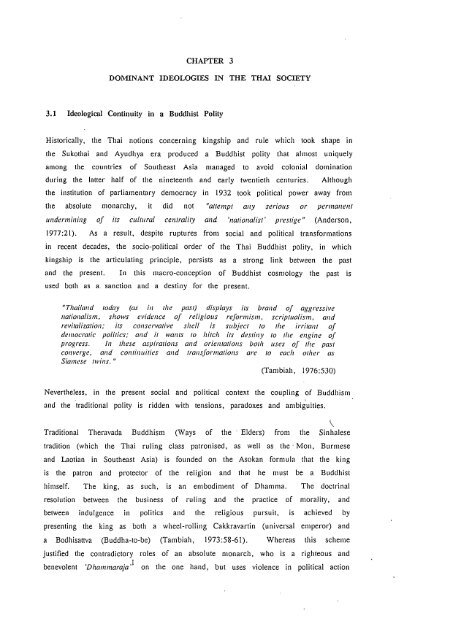iieiiei1eWrkers - Leicester Research Archive - University of Leicester
iieiiei1eWrkers - Leicester Research Archive - University of Leicester
iieiiei1eWrkers - Leicester Research Archive - University of Leicester
You also want an ePaper? Increase the reach of your titles
YUMPU automatically turns print PDFs into web optimized ePapers that Google loves.
CHAPTER 3<br />
DOMINANT IDEOLOGIES IN THE THAI SOCIETY<br />
3.1 Ideological Continuity in a Buddhist Polity<br />
Historically, the Thai notions concerning kingship and rule which took shape in<br />
the Sukothai and Ayudhya el-a produced a Buddhist polity that almost uniquely<br />
among the countries <strong>of</strong> Southeast Asia managed to avoid colonial domination<br />
during the latter half <strong>of</strong> the nineteenth and early twentieth centuries. Although<br />
the institution <strong>of</strong> parliamentary democracy in 1932 took political power away from<br />
the absolute monarchy, it did not "attempt any serious or permanent<br />
undermining <strong>of</strong> its cultural centrality and 'nationalist' prestige" (Anderson,<br />
1977:21). As a result, despite ruptures from social and political transformations<br />
in recent decades, the socio-political order <strong>of</strong> the Thai Buddhist polity, in which<br />
kingship is the articulating principle, persists as a strong link between the past<br />
and the present. In this macro-conception <strong>of</strong> Buddhist cosmology the past is<br />
used both as a sanction and a destiny for the present.<br />
"Thailand today (as in the past) displays its brand <strong>of</strong> aggressive<br />
nationalism, shows evide,zce <strong>of</strong> religious reformism, scriptualism, a/id<br />
revitalization; its conservative shell is subject to tile irritant <strong>of</strong><br />
democratic politics,- and it wants to hitch its destiny to the engine <strong>of</strong><br />
progress. In these aspirations and orientations both uses <strong>of</strong> tue past<br />
converge, and continuities a/Id transformations are to each other as<br />
Siamese twins.<br />
(Tanibiah, 1976:530)<br />
Nevertheless, in the present social and political context the coupling <strong>of</strong> Buddhism<br />
and the traditional polity is ridden with tensions, paradoxes and ambiguities.<br />
Traditional Theravada Buddhism (Ways <strong>of</strong> the Elders) from the Sinhalese<br />
tradition (which the Thai ruling class patronised, as well as the Mon, Burmese<br />
and Laotian in Southeast Asia) is founded on the Asokan formula that the king<br />
is the patron and protectoi <strong>of</strong> the religion and that he must be a Buddhist<br />
himself. The king, as such, is an embodiment <strong>of</strong> Dhamma. The doctrinal<br />
resolution between the business <strong>of</strong> ruling and the practice <strong>of</strong> morality, and<br />
between indulgence in politics and the religious pursuit, is achieved by<br />
presenting the king as both a wheel-rolling Cakkravartin (universal emperor) and<br />
a Bodhisattva (Buddha-to-be) (Tambiah, 1973:58-61). Whereas this scheme<br />
justified the contradictory roles <strong>of</strong> an absolute monarch, who is a righteous and<br />
benevolent 'Dhammaraja' 1 on the one hand, but uses violence in political action














